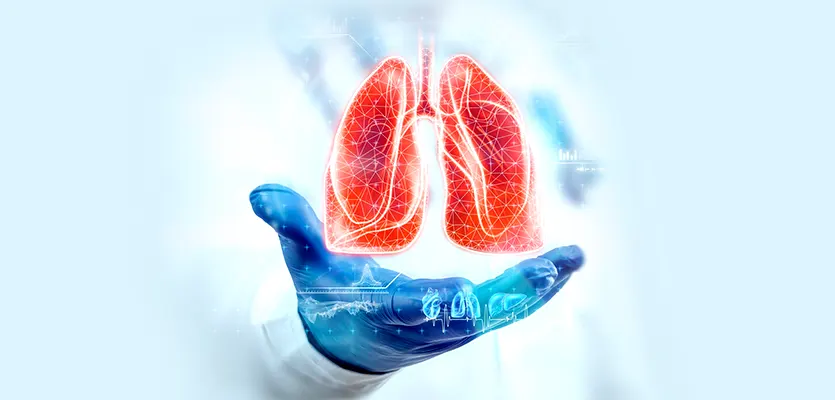A report published in Lancet Global Health suggests that the burden of chronic respiratory disease in India accounts for 32% of the global burden. The numbers thus indicate a dire need for effective and advanced lung transplant procedures in India.
Over the decades, Lung transplant in India has come a long way since the first breakthrough in 1999. A lung transplant is a life-saving procedure that involves the replacement of the diseased lung in the patient with a healthy donor lung.
Scroll down for detailed information about the lung transplant procedure, its prevalence in India, and how you can prepare for it.
What is Lung Transplant?
A lung transplant is an advanced surgical procedure involving the replacement of the diseased, damaged or infected lung with a healthy donor lung.
It is often treated as a last resort in patients who aren’t responding to the medications or other assistive therapies for their condition. Additionally, a lung transplant can either include replacing one or either of the failing lungs to reward the patient with better quality of life.
If you are faced with the decision of a lung transplant, things can seem very complicated and uncertain. We will discuss and make understanding more of that much easier in the following parts.
What are the Eligibility Criteria for Lung Transplant?
A lung transplant is a highly advanced and sensitive surgical procedure. Since the replacement lung is often from a deceased donor, who it goes to matters a lot. There are a lot of factors at play when it comes to determining the eligibility criteria.
Typically, the age limit for lung transplantation is 65 years, but there might be exceptions to the same.
That said, the patients who qualify for a lung transplant might suffer from any of the following lung diseases:
- Chronic obstructive pulmonary disease (COPD) like emphysema, chronic bronchitis
- Interstitial lung disease
- Pulmonary fibrosis
- Pulmonary hypertension
- Bronchiectasis
- Sarcoidosis
- Alpha-1-antitrypsin deficiency
- Cystic fibrosis
- Lymphangioleiomyomatosis
Additionally, the qualifying patients are those who aren’t responding to any other type of treatment, including oral medications, oxygen therapy, etc.
Complete Process of Lung Transplant
The entire procedure of a lung transplant involves three phases – pre-surgical preparation, surgical procedure or the transplantation, and post-surgical recovery.
When you rely on a lung transplant to save your life, being on the waiting list is frustrating and emotionally impacts you.
Generally, the waiting list for a lung transplant depends on multiple factors, including:
- Availability of a lung that matches
- The blood type of the patient and donor
- The severity of the condition of the patient
- Size and health of the donors lung
- Overall health and well-being of the patient
While you are on the waiting list for a lung transplant, the pre-operative evaluation and procedure kick off on the sidelines.
How to Prepare for a Lung Transplant Surgery?
Preparations for a lung transplant surgery are a lengthy process and start way before the actual surgery. We begin the processing a few weeks or months ahead of the surgery, depending on the patient’s health.
The first step of the preparation is to undergo a comprehensive evaluation. Determining whether or not the patient is ready and physically healthy enough to undergo surgery is crucial, primarily because of the scarce availability of the donors lungs.
The thorough evaluation checks whether the patient is eligible for the lung transplant procedure. This involves:
- Reviewing the medical history of the patient
- Assessing the current physical health of the patient
- Get through blood tests and imaging tests done
- Evaluate the emotional state of the patient
Our pre-surgical evaluation also involves having an open and transparent discussion about the procedure with the patient. We discuss the procedure, the risks involved, and the road to recovery. We aim to ensure that our patients are as informed as possible to make decision-making easier for them.
How is the Lung Transplant Surgery Performed?
Once the patient is matched with a donors lung, the following steps are extremely fast-paced. As the lung transplant arrives at the hospital, the patient is simultaneously prepared for the surgery.
Preparation for the surgery involves shifting the patient to the operating theater, channeling the IV, and also sorting out the anesthesia process. The procedure is done under general anesthesia.
To ensure proper breathing, blood supply, and oxygenation, a tube is inserted into the windpipe to help the patient breathe. In some cases, the patient is also put on the heart-lung machine to ensure that the blood is pumped optimally throughout the body.
As the accessory procedures are out of the way, the transplant surgeon initiates the procedure by making a large incision in the chest. This is where the diseased or failing lung is excised and removed and the donors lung is transplanted. The new lung is also connected to the primary blood vessels and airways to ensure it functions optimally.
Once the transplant is done, we cross-check every little function of the new lung to ensure that the transplant was successful, after which the incision is stitched back. The vitals are recorded, and the patient is then transferred to an ICU for observation and recovery.
Recovery after Lung Transplant
Right after the transplantation, the patient is transferred to an ICU, where they have to spend the next few days in recovery. They are connected to a mechanical ventilator to support their breathing, and several tubes are attached to drain excess fluid out of the heart and lungs.
The relevant medications are prescribed to help manage the discomfort and pain and also prevent any risks of rejection and infection after the transplantation.
Following discharge from the hospital, the patient has to remain under close monitoring for the next three months. This includes frequent follow-ups and also keeping an eye out on the patients condition.
A lung biopsy is also conducted a few weeks after the transplantation to check for potential signs of rejection or infection in the transplanted lungs. The patient is also put on immunosuppressant medications to allow the body to adjust to the new organ and get used to it.
Recovery also involves shifting and adjusting to an entirely new lifestyle, which requires being on multiple types of medications, medical check-ups, leading a healthy lifestyle, and getting the emotional support one needs to get through this big change in life.
What is the Cost of a Lung Transplant in India?
The cost of lung transplants in India varies and depends on multiple factors. According to the average reports from varying hospitals, the minimum cost of lung transplant surgery in India is INR 25,00,000/-
The amount can go upwards of INR 35,00,000 and more, depending on the state where the surgery is performed, the surgeons experience and expertise, the hospital in which it is performed and the course of the patient after the procedure.
Why Choose Us?
Lung Transplant is a highly sensitive and life-saving surgery that requires the skills and expertise of a highly qualified surgeon.
- Dr. Arvind Kumar (MBBS (AIIMS), MS (Surgery, AIIMS), MNAMS, FACS (USA), FICS (USA), FUICC) is a leading Chest Surgeon in India with 40+ years of experience. He has performed over 2000 major chest surgeries, being one of the best in India.
- Our transplant center is equipped with state-of-the-art facilities, advanced medical equipment, and infrastructure to ensure smooth surgical interventions and optimal recovery.
- The lung transplant unit is supported by a highly experienced medical board from varying specialties to ensure a higher success rate of the surgery with little to no post-surgical complications.
- The responsibilities of a surgeon and healthcare-providing unit don’t stop with the surgery. Instead, we are heavily focused on ensuring quicker and steady recovery of our patients with close monitoring and follow-up care.
For more details, kindly visit drarvindkumar.com.

.webp)



